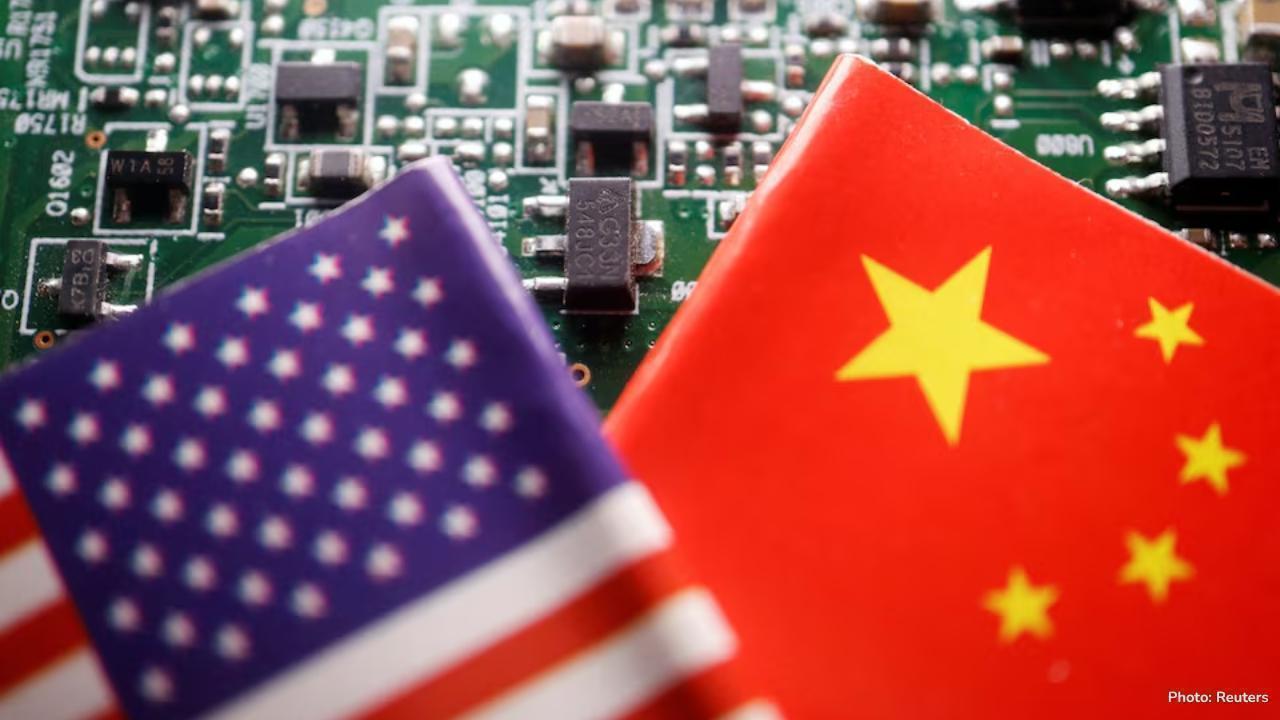
Post by : Monika
China’s technology industry is showing surprising strength, despite strong restrictions from the United States and its allies. A recent report has revealed that Chinese chip companies bought about $38 billion worth of semiconductor equipment from the U.S. and allied countries this year. This number shows that Washington’s efforts to slow China’s chip progress may not be working as planned.
The large amount of spending suggests that Chinese manufacturers are still finding ways to get advanced tools needed to make chips — which are the tiny parts that power computers, phones, and cars. The data comes from trade and import records, showing that China’s demand for chipmaking machines remains high even after years of export bans.
Background: The Global Chip War
In recent years, the U.S. government has tried to stop China from gaining access to advanced chip technology, fearing it could strengthen Beijing’s military and artificial intelligence programs. Washington has banned U.S. companies like Applied Materials, Lam Research, and KLA Corp from selling their most advanced tools to China.
Other countries, including Japan and the Netherlands, have joined the restrictions. These nations are home to key equipment makers like Tokyo Electron and ASML, which produce machines essential for making modern microchips.
However, the latest trade figures indicate that despite these efforts, Chinese companies are still importing large amounts of older but still useful chip tools. Many of these machines can be used to make slightly less advanced chips, which are still vital for smartphones, vehicles, and factory equipment.
How China Keeps Buying
Experts say that Chinese buyers are not violating the export rules directly. Instead, they are focusing on machines that are not banned or using indirect channels through subsidiaries and foreign trade partners. Some equipment that was made before new restrictions came into effect is also being shipped legally.
A report by Bloomberg and other global media noted that while high-end chip tools are blocked, China has become extremely skilled at buying mid-level machines in huge volumes. The strategy allows them to continue producing large quantities of chips that power most consumer electronics.
Chinese chipmakers like SMIC (Semiconductor Manufacturing International Corp) and Hua Hong Semiconductor have also upgraded their existing tools to get better performance. Engineers say that these firms are becoming more creative in improving their output, even without the latest Western technology.
U.S. Policy Faces Challenges
The U.S. government introduced export controls in October 2022, aiming to limit China’s chip-building capacity. Officials believed that without advanced tools, Chinese companies would fall behind competitors in Taiwan, South Korea, and the United States.
But the new numbers show the opposite trend. Instead of slowing down, China’s chip production has increased, and its imports of Western equipment have grown sharply. According to trade data, in the first eight months of 2025 alone, imports of chipmaking tools from the Netherlands, Japan, and the U.S. rose by nearly 45% compared to the same period last year.
This pattern has caused growing concern in Washington. Some lawmakers are calling for tighter rules and better monitoring of indirect sales. They worry that the current restrictions are too easy to bypass and that China’s rapid adaptation could weaken America’s technological edge.
China’s Domestic Push for Self-Reliance
China has also been working hard to develop its own chip tools and manufacturing technologies. The government has invested billions of dollars into its “Made in China 2025” and “National Integrated Circuit Fund” programs. These initiatives aim to make the country self-reliant in producing critical technologies.
Over the past year, Chinese companies have made progress in building homegrown lithography machines and testing tools, though they still lag behind global leaders like ASML. Even so, experts believe that with time, China may close the gap further.
An economist from Beijing’s Tsinghua University said, “Every new restriction from the U.S. gives China a reason to innovate faster. The sanctions slow us in the short term but push us to work harder for independence.”
Reactions from Around the World
In Japan and Europe, some companies have quietly expressed frustration over U.S. pressure to limit sales. Equipment makers like ASML and Tokyo Electron depend heavily on revenue from China, which is one of their biggest markets. Industry analysts say that cutting off such a large market could hurt Western firms financially, even as they try to follow their governments’ rules.
Meanwhile, in the U.S., some business groups have warned that too many restrictions could backfire. They argue that by forcing China to build its own chip tools, Washington might actually help create new global competitors in the long term.
The Bigger Picture: Global Tech Competition
The chip industry has become one of the main battlegrounds in the global power struggle between the U.S. and China. Microchips are essential for modern life — from smartphones to fighter jets — and controlling them means controlling the future of technology.
Washington wants to keep its lead by protecting its most advanced chip technologies. China, on the other hand, sees chips as the foundation of its future economic and military strength. Both sides are investing billions to gain the upper hand.
The recent data showing China’s $38 billion purchase is a reminder that global trade is complex and deeply connected. Even with strict rules, complete separation between Western and Chinese industries is proving nearly impossible.
What Comes Next
Experts believe that the U.S. may soon introduce stricter enforcement measures, possibly targeting middlemen or countries that re-export tools to China. However, this could create new tensions with allies who rely on China for trade.
At the same time, Chinese firms are expected to keep buying whatever equipment they can get. Some may also start reverse-engineering existing tools to build local versions. Already, small Chinese startups are emerging in the semiconductor equipment market, developing parts for etching, testing, and packaging.
Economists predict that even if China cannot produce the most advanced chips right now, its ability to mass-produce mid-range chips will still make it a strong player in the global market. These chips are widely used in electric vehicles, industrial robots, and smart home devices — sectors that continue to grow rapidly.
The story of China’s $38 billion in chip tool imports shows that the global tech war is far from one-sided. The U.S. and its allies are trying to slow China’s progress, but the Asian giant is finding new ways to move forward. Through smart strategies, domestic innovation, and flexible trade routes, China’s chip industry is not just surviving — it is adapting and growing stronger.
This trend may lead to an even more divided global technology world, where two parallel systems develop — one led by the U.S. and another by China. For now, however, the numbers speak clearly: China remains deeply connected to Western technology, and its ambitions in chipmaking are only becoming bigger.










NBA Friday Recap: Powerhouse Wins for Miami, LA, Milwaukee, and Clippers
Miami, LA Lakers, Milwaukee, and Clippers triumphed in a thrilling NBA Friday, showcasing standout p

Doncic Shines with 49 Points in Lakers' 128-110 Victory over Timberwolves
Luka Doncic dazzles with 49 points as the Lakers secure a 128-110 win against the Timberwolves, show

Kings Triumph Over Jazz 105-104 with Last-Minute Sabonis Effort
The Sacramento Kings edged out the Utah Jazz 105-104, with Domantas Sabonis making the decisive shot

Argentina's Friendly Match Against India Delayed, New Date to be Announced
The friendly match between Argentina and India in Kochi has been postponed due to FIFA approval dela

Rohit and Kohli Conclude ODI Journeys in Australia with a Victory
Rohit Sharma and Virat Kohli bid adieu to Australian ODIs with a final win, forming a 168-run partne

George Russell's Wrestling Mask Antics at Mexican Grand Prix
George Russell donned a wrestling mask to enjoy the Mexican Grand Prix from the stands, providing a